第四纪灭绝事件
第四纪灭绝事件,或称冰河时期灭绝事件,是于第四纪发生的大量巨型动物群的灭绝事件,大部分都是在过渡到全新世之间发生的。有些学者会将此次生物集群灭绝看为全新世灭绝事件之一,也有认为是独立事件。古生物学家认为其成因可能是气候转变、疾病的传播、陨石撞击、或被人类过度猎杀等。
灭绝事件
第四纪灭绝事件主要涉及重于40公斤的大型哺乳动物。在北美洲,约有33属大型哺乳动物消失;在南美洲就有46属;澳洲有15属;欧洲有15属;而撒哈拉以南非洲就只有两属。在美洲的灭绝事件中,所有源自南美洲在南北美洲生物大迁徙中向北迁徙的也都消失。各大洲中只有南美洲及澳州涉及科以上分类的灭绝。第四纪灭绝事件的成因有两个主要的假说:气候转变及人类猎杀。[1]
证据指某些岛上的巨型动物群比在大洲中的生存多几百万年;例如在安地列斯群岛的地懒就比在美洲的生存得较长。后者的消失是与人类到达美洲有关。同样地,真猛犸在弗兰格尔岛上也较大陆的迟7000年才消失。在偏远的科曼多尔群岛上的大海牛也较北太平洋海岸的迟几千年消失。[2]不过,这个过度猎杀的假说也存在一问题。例如,就澳洲巨型动物群突然灭绝的时间很含糊。生物学家指在非洲及南亚或东南亚也有人类居住,但却没有大量的灭绝事件。冰河时期后非洲巨型动物群的灭绝也相隔了一段长时间。
其他的理论就指生物集群灭绝是因火流星撞击所致。不过,这些假说应该会造成即时及区域性的灭绝事件,却不能解释涉及全地球及经历几千年的灭绝事件。
主要灭绝的巨型动物群
|
更多信息:更新世巨型动物群 |
欧亚大陆
地中海群岛
北美洲
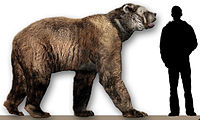
|
参见:全新世灭绝的北美动物名单 |
在过往5万年中,包括末次冰期晚期,约有33属的大型动物于北美洲消失。当中15属约于1.15-1万年前的期间消失,仅在克洛维斯人到达北美洲之后。其他大部分的消失并不受时间的约束,但一些则肯定是在这段时期之外。[3]相反,此段时期却只有少量细小哺乳动物消失,以往在北美洲的灭绝波浪却没有这种不平衡。
以下是在北美洲消失的动物:
南美洲
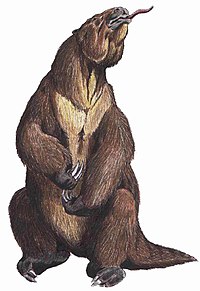
|
参见:全新世灭绝的南美动物名单 |
于更新世及全新世过渡期的南美洲大多都是没有结冰的,不过却同样遭遇了灭绝事件。现时仍存活的野生陆上哺乳动物都不会大于一只貘。
以下是在南美洲消失的动物:
澳洲
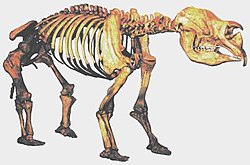
澳洲发生的一连串灭绝事件要比在美洲发生的为早。大部分证据都指向人类到达之后的时期,约于5万年前,但是实际年期仍有争议。澳洲灭绝的有:
另外在澳洲有一些已灭绝的巨型动物群可能是古代的神秘生物,如像本耶普的双门齿兽。
非洲
猎杀假说
猎杀假说尝试解释第四纪灭绝事件的发生,指人类猎杀巨型草食性动物至灭绝状况,结果令肉食性及食腐动物没有猎物而也消失。[4][1][5]因为在一些巨型动物群的化石旁一并发现有人类的遗骸、箭及工具,化石骨头上有伤痕,石洞壁画也描绘猎杀的境象。生物地理学证据指人类演化的地区,对比没有早期人类的澳洲、美洲、马达加斯加及新西兰等,于更新世存有较多样化的巨型动物群。所以可见在亚洲及非洲的巨型动物群已学懂如何与人类相处,反而其他地区的动物则易于被猎杀。
在一些地区人类出现的时间与灭绝事件的时间吻合,例如真猛犸在岛上生活至末次冰期之后几千年,但到了前1700年人类到达后就消失了。澳洲最早的灭绝事件在3万年前就已经完结,远早于末次冰期及气温上升等的气候转变。在新西兰最近的灭绝事件则是在500年前完结。在这段时间之间就不断发生灭绝事件,包括在北美洲、南美洲及马达加斯加,但却没有气候上的共通性。唯一共通的地方就是人类的出现。[6]

全球性的灭绝究件似乎与人类迁徙有关,当人类到达一些地区时,灭绝事件会变得严重。但在发源地的非洲,情况是最不严重的,可见在非洲猎物是与人类的狩猎能力一同进化,学习了逃避的能力。人类走到世界各地,狩猎能力就不断进步。非洲动物演化成不惧怕人类,而其他地方的则成为了容易的猎物。
猛犸象的遗骸骨骼中发现了被抛掷的伤痕,可见人类猎杀至灭绝的可能性。[7][8][9][10][11][12]
不过有意见认为当时狩猎收集者社会的出生率过低,杀死一只巨型动物已经需要付出很大的努力,更何况是将巨型动物群猎杀至灭绝状况,而且得来的肉量也远远超出他们所需。[13]从北美洲的拉科塔可见,他们只会取其所需的美洲野牛,每只猎杀回来的野牛也会完全用上,并不会浪费。[14]
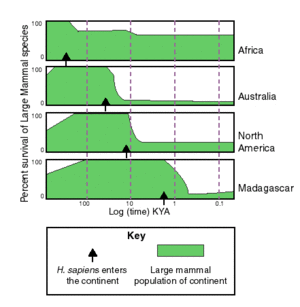
猎杀假说的一个变化就是过度猎杀假说。这个假说指巨型动物群是于极短的时间内消失,例如80%的北美洲大型动物就于人类到达西半球的1000年间消失。不过,这套假说仍然被受争议。
对于猎杀假说就主要有以下的质疑:
- 在掠食者及猎物的世界里,掠食者是不会过度猎杀猎物,因为猎物是其维生及繁殖的食物。[15]不过,人类是所有掠食者中食性最广的,不单会吃动物,也会吃植物,而且人类也曾将大量动物猎杀至灭绝。
- 除了猛犸象、乳齿象、嵌齿象科及美洲野牛属外,其他的巨型动物群并没有考古学证明曾被猎杀。不过这只可能是有关的证据并没有存留下来。而生物化学分析显示一些马及骆驼被克洛维斯人的工具所宰杀。[16]
- 被猎杀的只是少量的动物,如美洲野牛属,而非至灭绝的状况。现存的美洲野牛只是由欧亚大陆迁徙至北美洲,原先居住在北美洲的3个特有种都已经灭绝。
- 猎杀假说不能解释动物的侏儒化。很多学者却指动物的侏儒化是为了适应人类选择性猎杀大型动物的后果,于20世纪仍存在着这种情况。
- 更新世欧亚大陆的巨型动物群于差不多于同时消失,不足以适应人类猎杀的压力。不过,欧亚大陆巨型动物群的灭绝可能是北美洲的有所不同。在北美洲的大型动物是在人类突然出现而消失,欧亚大陆的事件是几千年来人类猎人向北迁徙的累积结果。
- 克洛维斯人是否第一批到达新世界的人类现被受争议。
气候转变假说
于19世纪末及20世纪初,科学家第一次发现曾出现冰河时期及间冰期,且与某些动物的兴衰有关,于是结论出更新世冰河时期的完结就是灭绝事件的原凶。
不过有指这么多次的冰河时期,为何只有末次冰期与灭绝事件有关?一些证据更指这套假说不能适用于澳洲,因灭绝事件发生时期(4-5万年前)的气候是与现今的差不多,而且澳洲的巨型动物群也完全适应干旱的气候。另外,证据显示所有的灭绝事件都是在很短的时间内发生,恰巧正好是人类到达澳洲。同位素分析发现一些存留下来的物种突然转变食性来面对生存的压力。[17][18][19]
气温上升
最明显的气候转变是在冰河时期末的气温上升。于1.5-1万年前,全球就有6℃的上升,可能就是灭绝的原因。上升的温度足以溶解威斯康辛冰期的冰川,令适应寒冷的动物死亡。大型动物身体的表面积比例也较细小动物的为少,故问题更为严重。
研究却发现间冰期的全年平均温度并不比以往1万年的气温为高,故大型动物仍能生存,较温暖的气候并非足够的解释。[20][21][22][23][24][25]
再者,纵然气温上升,在弗兰格尔岛[26]及圣保罗岛上仍生存着一些猛犸象的物种。在正常生态下,在岛内生存的群落应更为易于受害,因为在岛内的群落往往较少,,且缺乏迁徙的能力。
陆性率上升
其他科学家指极端气候的频繁,如较热的夏天及寒冷的冬天、或雨量的改变导致灭绝。研究发现林地及山簏变成草原及林地[23][25][22],令动物的食物量减少。草食性动物可能找不到与牠们一同演化的植物,而成为了一些含有抗草食性动物毒素植物的猎物。较短的生长季节令大型草食性动物灭绝或侏儒化。美洲野牛及反刍动物能够从有限的食物中抽取更多的养份,故能处理抗草食性动物的毒素。[27][28][29]所以当植物变得更为专门化时,草食性动物就会失去食性的灵活性,很难寻找食物来维生及繁殖。
下降及难以预测的雨量限制了植物的生长,令陆性率增加[30][31][32],限制了适合繁殖的时间。[33][34]这样会对大型动物造成伤害,因其繁殖季节较长及灵活性较低,而幼生会在不适当的时间出生。相反,细小的哺乳动物因生命周期、繁殖循环及妊娠期较短,能够调校自己适应新的气候。若是这样,牠们会失去较少的幼生,且能在适合生存的季节下重复繁殖。[35]
以下是陆性率上升未能解决的问题:
- 巨型草食性动物在其他时期的相同气候下仍有繁盛的例子,例如于更新世的西伯利亚。[36][37][38]
- 灭绝的动物所吃的食物:草,就算环境由林地及山簏变为草原,也有增加而非减少。[39][38][40]
- 虽然马在新世界中消失,但却于16世纪成功由西班牙引入。牠们能够避开毒素找到食物,而妊娠期的时间并没有影响其繁殖。同样地,猛犸象于更新世-全新世间生存下来,到了没人居住的地中海岛[41]及弗兰格尔岛[42]上直至4000-7000年前。
- 若大型哺乳动物发现气温过于极端、繁殖季节太短或雨量太少时,牠们应该有能力永久或季节性迁徙。[43]季节会按地理而改变。只要迁离赤道,草食性动物就可以找到适合生活的地方进行繁殖。现今的非洲象就会因干旱而迁徙到有水源的地方。[44]
- 大型动物的身体内可以储存较多的脂肪[45],可以用来抵消于极端气候下的食物供应。
超级传染病假说
有指更新世晚期大型哺乳动物的灭绝是一种超级传染病所致,且是人类到达后的间接影响。[46][47][48]人类与禽畜带来了一种病毒性极高的疾病,感染原住的哺乳动物,最终引致牠们的灭绝。由于细小的物种有较高的适应力,所以只有大型的物种消失。在以往也有相似的例子,如在夏威夷所爆发的禽类疟疾,就对岛上的鸟类带来巨大影响。
假说背后必需存在一些先决条件:
- 病原体必定有一个稳定的带菌者状态,可以在未有适合的宿主前自我生存;
- 病原体必须具有高度的感染率,能感染所有不同年龄及性别的个体;
- 致命率必须极高,最少达到50-75%;
- 它们能够感染多种宿主,但却对人类无害。
有指病原体是由扩展中的人类传染给家犬。[49]但是这却不能解释很多灭绝事件,例如犬科要比人类迟3.5万年才到达澳洲,这要比灭绝事件迟3万年出现。另外大量物种,如狼、猛犸象、骆驼及马于10万年前经常穿越亚洲及北美洲,同时也会出现基因及病原体的传播。
超级传染病假说也有其缺点如下:
次级掠食
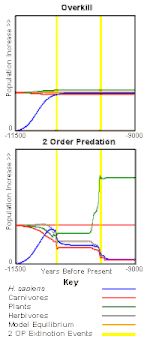
(下)次级掠食假说。

(中)气候转变及过度猎杀假说
(下)气候转变、过度猎杀及次级掠食假说。
次级掠食假说指人类进入到新世界后,继续猎杀掠食者,产了生态不平衡,导致大洲上的物种数量过剩,耗尽环境而令环境崩坏。在智人到达新世界后,当地的掠食者与牠们一同争夺猎物,令初级掠食者不能找到足够的食物。人类开始猎杀初级掠食者,掠食已不能控制猎物的数量。由于失去了初级掠食的控制,猎物群落出现了兴衰循环,数量激增致过度牧食,令环境不能再支撑。结果草食性动物出现饥荒,寻找食物较慢的物种率先灭绝,紧接是未能从食物中有效抽取养份的动物。由于植物环境改变,引发了气候(相对湿度及陆性率)的转变,林地变为草坪。
利用电脑模型发现次级掠食比过度猎杀更为接近灭绝事件。[51]不同假说的组合也由电脑来模拟。当过度猎杀及气候转变组合起来后,它们彼此抵消。气候转变只令植物减少,过度猎杀则令动物消失,故较少植物被吃掉。次级掠食加上气候转变会令灭绝事件恶化。[52]
不过次级掠食也有其问题:
- 除了西伯利亚外,没有证据指人类会猎杀掠食者。[53]
- 只预测了因气候转变而造成的大量灭绝,但不能解释为何融冰期没有灭绝事件出现,或是在欧亚大陆的灭绝事件只在高海拔地方出现。
- 假设了气候转变令植物减少,但忽略了融冰扩大了北美洲的可住地区。
- 虽然在美国南部的气候转变对植物或细小的哺乳动物只有很少的影响,但忽略了美洲热带的灾难性灭绝事件。
- 任何植物性的改变都不足以令差不多所有细小的脊椎动物灭绝。
- 假设了在草原的高灭绝率,但大部分灭绝的物种分布在多种不同的植被地区,在森林的灭绝情况也一样严重。
- 由于一些掠食者的繁殖率也很高,假说却未能解释为何牠们在缺乏竞争者下,数量上未有增加。
- 没有解释为何差不多所有已灭绝的肉食性动物都专吃巨型草食性动物,而大部分低或一般肉食性动物却能生存下来。
- 历史上未曾出现动物的兴衰循环所引发的灭绝事件。近年在美国大量猎杀掠食者也不见得出现大量植被的改变。
陨石假说
|
主条目:新仙女木事件 |
陨石假说指于12900年前,陨星或彗星撞击北美洲引发了灭绝事件,称为新仙女木事件。显微照相分析发现在北美洲6个位点的土壤中含有奈米钻石,在格陵兰冰原也有发现奈米钻石[54][55][56]。由于并没有发现任何陨石坑及土壤中的铱含量相对较少,因此推测该天体是罕有的彗星群或球粒陨石群。
该假说推论,彗星在撞入大气后在五大湖上空爆炸,令冰盖融化,使北美大陆大部分地区陷于大火。融化的冰盖导致海水淡化,使北大西洋的温盐环流被破坏,使流向高纬度的暖流停止,北美气温骤降,最终令北半球气候急剧转变,使北半球急剧进入了一段持续1300年的冰川期(新仙女木期)。撞击事件直接冲击北美生物群,令北美早期人类克洛维斯文化消失,而气候的急剧转变也使北半球其它地区的多种大型动物最终灭绝。
相关条目
参考资料
- ^ 1.0 1.1 Martin P. S. Prehistoric overkill. ed. P.S. Martin and H.E. Wright (编). Pleistocene extinctions: The search for a cause. New Haven: Yale Univ. Press. 1967. ISBN 0-300-00755-8.
- ^ Anderson, Paul K. Competition, Predation, and the Evolution and Extinction of Steller’s Sea Cow, Hydrodamalis Gigas. Marine Mammal Science (Society for Marine Mammalogy). July 1995, 11 (3): 391–4 [2008-11-02]. doi:10.1111/j.1748-7692.1995.tb00294.x. (原始内容存档于2011-05-11).
- ^ Anthony D. Barnosky, Paul L. Koch, Robert S. Feranec, Scott L. Wing, Alan B. Shabel. Assessing the Causes of Late Pleistocene Extinctions on the Continents. Science. 2004, 306 (5693): 70–75. PMID 15459379. doi:10.1126/science.1101476.
- ^ Martin P. S. The last 10,000 years: A fossil pollen record of the American Southwest. Tucson, AZ: Univ. Ariz. Press. 1963. ISBN 0-8165-1759-2.
- ^ Martin P. S. Prehistoric overkill: A global model. ed. P.S. Martin and R.G. Klein (编). Quaternary extinctions: A prehistoric revolution. Tucson, AZ: Univ. Arizona Press. 1989: 354–404. ISBN 0-8165-1100-4.
- ^ Martin, Paul S. Twilight of the Mammoths: Ice Age Extinctions and the Rewilding of America. 2005.
- ^ Flannery, T. The future eaters: an ecological history of the Australasian lands and people. NY: George Braziller. 1995. ISBN 0-8021-3943-4.
- ^ Diamond, J. Historic extinctions: a Rosetta stone for understanding prehistoric extinctions. ed. P.S. Martin and R.G. Klein (编). Quaternary extinctions: A prehistoric revolution. Tucson, AZ: Univ. Arizona Press. 1984: 824–62. ISBN 0-8165-1100-4.
- ^ Diamond, J. Guns, germs, and steel; the fates of human societies. New York: Norton. 1997. ISBN 0-393-31755-2.
- ^ Mossiman, J. E., and Martin, P. S. Simulating Overkill by Paleoindians. American Scientist. 1975, 63: 304–13.
- ^ Whittington, S. L. & Dyke, B. Simulating overkill: experiment with the Mossiman and Martin model. ed. P.S. Martin and R.G. Klein (编). Quaternary extinctions: A prehistoric revolution. Tucson, AZ: Univ. Arizona Press. 1984: 451–66. ISBN 0-8165-1100-4.
- ^ Alroy, J. A multispecies overkill simulation of the end-Pleistocene megafaunal mass extinction (PDF). Science. 2001, 292: 1893 [2009-09-19]. doi:10.1126/science.1059342. (原始内容 (PDF)存档于2008-05-11).
- ^ Nadasdy, Paul. Transcending the Debate over the Ecologically Noble Indian: Indigenous Peoples and Environmentalism. Duke University Press. 2006 [2009-09-19]. (原始内容存档于2011-07-26).
- ^ Svenson, Sally. Bison. South Dakota Department of Game, Fish and Parks. 1995. (原始内容存档于2008-09-13).
- ^ May, R. M. Stability and complexity in model ecosystems. Princeton: Princeton Univ. Press. 2001. ISBN 0-691-08861-6.
- ^ Scott, J. Camel-butchering in Boulder, 13,000 years ago. Colorado Arts and Sciences Magazine. University of Colorado at Boulder. 2009-02-26 [2009-05-01]. (原始内容存档于2010-06-10).
- ^ Willis, Paul; Bryce, Clay; Searle, Mike. Thylacoleo - The Beast of the Nullarbor. Catalyst. 2006-08-17 [2009-09-21]. (原始内容存档于2019-05-09).
- ^ Gavin J. Prideaux; et al. An Arid-Adapted Middle Pleistocene Vertebrate Fauna from South-Central Australia. Nature. 2007-01-25, 445: 422–5 [2009-09-19]. doi:10.1038/nature05471. (原始内容存档于2017-04-04).
- ^ Richard G. Roberts; et al. New Ages for the Last Australian Megafauna: Continent-Wide Extinction About 46,000 Years Ago. Science. 2001-06-08, 292 (5523): 1888–92 [2009-09-19]. doi:10.1126/science.1060264. (原始内容存档于2009-03-01).
- ^ Andersen, S. T. The differential pollen productivity of trees and its significance for the interpretation of a pollen diagram from a forested region. ed. Birks, H. J. B. and West, R. G (编). Quaternary plant ecology: the 14thsymposium of the British Ecological society, University of Cambridge, 28–30 March 1972. Oxford: Blackwell Scientific Pubs. 1973. ISBN 0-632-09120-7.
- ^ Ashworth, C.A. Environmental implications of a beetle assemblage from the Gervais formation (Early Wisconsinian?), Minnesota. Quat. Res. 1980, 13: 200–12. doi:10.1016/0033-5894(80)90029-0.
- ^ 22.0 22.1 Birks, H. H. Modern macrofossil assemblages in lake sediments in Minnesota. ed. H. J. B. Birks, and R. G. West (编). Quaternary plant ecology: the 14thsymposium of the British Ecological Society, University of Cambridge, 28–30 March 1972. Oxford: Blackwell Scientific Pubs. 1973. ISBN 0-632-09120-7.
- ^ 23.0 23.1 Birks, H. J. B. & Birks, H. H. Quaternary paleoecology. Baltimore: Univ. Park Press. 1980. ISBN 1-930665-56-3.
- ^ Bradley, R. S. Quaternary Paleoclimatology: Methods of Paleoclimatic Reconstruction. Winchester, MA: Allen & Unwin. 1985. ISBN 0-04-551068-7.
- ^ 25.0 25.1 Davis, M. B. Pleistocene biogeography of temperate deciduous forests. Geoscience and man: ecology of the Pleistocene, vol.13. Baton Rouge: School of Geoscience, Louisiana State Univ. 1976.
- ^ Vartanyan, S.L., Arslanov, K.A., Tertychnaya, T.V. & Chernov, S.B. Radiocarbon dating evidence for mammoths on Wrangel Island, Arctic Ocean, until 2000 BC. Radiocarbon. 1995, 37: 1–6. (原始内容存档于2009-12-13).
- ^ Guthrie, R. D. Frozen Fauna of the Mammoth Steppe: The Story of Blue Babe. University Of Chicago Press. 1988. ISBN 0-226-31122-8.
- ^ Guthrie, R. D. Mosaics, allochemics, and nutrients: an ecological theory of Late Pleistocene megafaunal extinctions. ed. P.S. Martin and R.G. Klein (编). Quaternary extinctions: A prehistoric revolution. Tucson, AZ: Univ. Arizona Press. 1989: 259–99. ISBN 0-8165-1100-4.
- ^ Hoppe, P. P., Rumen fermentation in African ruminants. Proceedings of the 13th Annual Congress of Game Biologists, Atlanta, 1978
- ^ Bryson, R. A., Baerreis, D. A. & Wendland, W. M. The character of late-glacial and post-glacial climatic changes. ed. W. Dort, Jr. and J. K. Jones, Jr., Dept. Geol., Univ. Kan. Spec. Pub. 3 (编). Pleistocene and recent environments of the central Great Plains. Lawrence: Univ. Press Kan. 1970. ISBN 0-7006-0063-9.
- ^ Graham, R.W. & Lundelius, E.L. Coevolutionary disequilibrium and Pleistocene extinctions. ed. P.S. Martin and R.G. Klein (编). Quaternary extinctions: A prehistoric revolution. Tucson, AZ: Univ. Arizona Press. 1989: 354–404. ISBN 0-8165-1100-4.
- ^ King, J. E. and Saunders, J. J. Environmental insularity and the extinction of the American mastodont. ed. P.S. Martin and R.G. Klein (编). Quaternary extinctions: A prehistoric revolution. Tucson, AZ: Univ. Arizona Press. 1989: 354–404. ISBN 0-8165-1100-4.
- ^ Axelrod, D. I. Quaternary extinctions of large mammals. University of California Publications in Geological Sciences. 1967, 74: 1–42. ASIN B0006BX8LG.
- ^ Slaughter, B. H. Animal ranges as a clue to late-Pleistocene extinction. ed. P.S. Martin and H.E. Wright (编). Pleistocene extinctions: The search for a cause. New Haven: Yale Univ. Press. 1967. ISBN 0-300-00755-8.
- ^ Kilti, R. A. Seasonality, gestation time, and large mammal extinctions. ed. P.S. Martin and R.G. Klein (编). Quaternary extinctions: A prehistoric revolution. Tucson, AZ: Univ. Arizona Press. 1988: 354–404. ISBN 0-8165-1100-4.
- ^ Flereov, C. C. On the origin of the mammalian fauna of Canada. ed. D.M. Hopkins (编). The Bering Land Bridge. Palo Alto: Stanford Univ. Press. 1967: 271–80. ISBN 0-8047-0272-1.
- ^ Frenzel, B. The Pleistocene vegetation of northern Eurasia. Science. 1968, 161: 637–49. doi:10.1126/science.161.3842.637.
- ^ 38.0 38.1 McDonald, J. The reordered North American selection regime and late Quaternary megafaunal extinctions. ed. P.S. Martin and R.G. Klein (编). Quaternary extinctions: A prehistoric revolution. Tucson, AZ: Univ. Arizona Press. 1989: 354–404. ISBN 0-8165-1100-4.
- ^ Birks, H. J. B. and West, R. G. Quaternary plant ecology: the 14th symposium of the British Ecological society, University of Cambridge, 28–30 March 1972. Oxford: Blackwell Scientific Pubs. 1973. ISBN 0-632-09120-7.
- ^ McDonald, J. North American Bison: Their classification and evolution.. Berkeley: Univ. Calif. Press. 1981. ISBN 0-520-04002-3.
- ^ Burney, D. A. Recent animal extinctions: recipes for disaster. American Scientist. 1993, 81 (6): 530–41.
- ^ Vartanyan, S.L., Garutt, V. E. and Sher, A.V. Holocene dwarf mammoths from Wangel Island in the Siberian Arctic. Nature. 1993, 362: 337–40. doi:10.1038/362337a0.
- ^ Pennycuick, C.J. Energy costs of locomotion and the concept of "Foraging radius". ed. A.R.E. Sinclair and M. Norton-Griffiths (编). Serengetti: Dynamics of an Ecosystem. Chicago: Univ. Chicago Press. 1979: 164–85. ISBN 0-226-76029-4.
- ^ Wing, L.D. & Buss, I.O. Elephants and Forests. Wildl. Mong. 1970, (19).
- ^ Owen-Smith, R.N. Megaherbivores: The influence of very large body size on ecology. Cambridge studies in ecology.. Cambridge: Cambridge Univ. Press. 1992. ISBN 0-521-42637-5.
- ^ MacFee, R.D.E. & Marx, P.A. Humans, hyperdisease and first-contact extinctions. eds S. Goodman & B.D. Patterson (编). Natural Change and Human Impact in Madagascar. Washington D.C.: Smithsonian Press. 1997: 169–217. ISBN 1-56098-683-2.
- ^ MacFee, R.D.E. & Marx, P.A. Lightning Strikes Twice: Blitzkrieg, Hyperdisease, and Global Explanations of the Late Quaternary Catastrophic Extinctions. American Museum of Natural History. 1998 [2009-09-19]. (原始内容存档于2021-02-25).
- ^ MacPhee, Ross D.E.; Preston Marx. The 40,000-year Plague: Humans, Hyperdisease, and First-Contact Extinctions. Natural Change and Human Impact in Madagascar. Washington, D.C.: Smithsonian Institution Press. 1997: 169–217.
- ^ Fiedel, S. Man's best friend: mammoth's worst enemy?. World Archaeology. 2005, 37: 11–35.
- ^ Lyons, K, Smith, F.A., Wagner, P.J., White, E.P., and Brown, J.,H. Was a 'hyperdisease' responsible for the late Pleistocene megafaunal extinction? (PDF). Ecology. 2004, 7: 859–68. (原始内容 (PDF)存档于2006-05-27).
- ^ Whitney-Smith, E. Late Pleistocene extinctions through second-order predation. eds C. M. Barton, G. A. Clark, D. R. Yesner (编). Settlement of the American Continents: A Multidisciplinary Approach to Human Biogeography. Tucson, AZ: University of Arizona Press. 2004. ISBN 0-8165-2323-1.
- ^ Whitney-Smith, E. Clovis and Extinctions – Overkill, Second Order Predation, Environmental Degradation in a Non-equilibrium Ecosystem "Clovis Age Continent". University of New Mexico Press. 2006.
- ^ Soffer, O. The Upper Paleolithic of the Central Russian Plain. Orlando, Florida: Academic Press. 1985. ISBN 0-12-654270-8.
- ^ Study links mammoth extinction, comets. USA Today. 2009-02-01 [2009-04-04]. (原始内容存档于2012-09-15).
- ^ Evan Hadingham. The Extinction Debate. NOVA. [2009-04-04]. (原始内容存档于2021-02-26).
- ^ Last Extinction. NOVA. 2009-03-31 [2009-04-04]. (原始内容存档于2021-02-26).
外部链接
- American Museum of Natural History (页面存档备份,存于互联网档案馆)
- J.H. Brown (University of New Mexico). Was a hyperdisease responsible?
- Elin Whitney-Smith (页面存档备份,存于互联网档案馆)
| ||||||||||||||||||||
Text is available under the CC BY-SA 4.0 license; additional terms may apply.
Images, videos and audio are available under their respective licenses.

